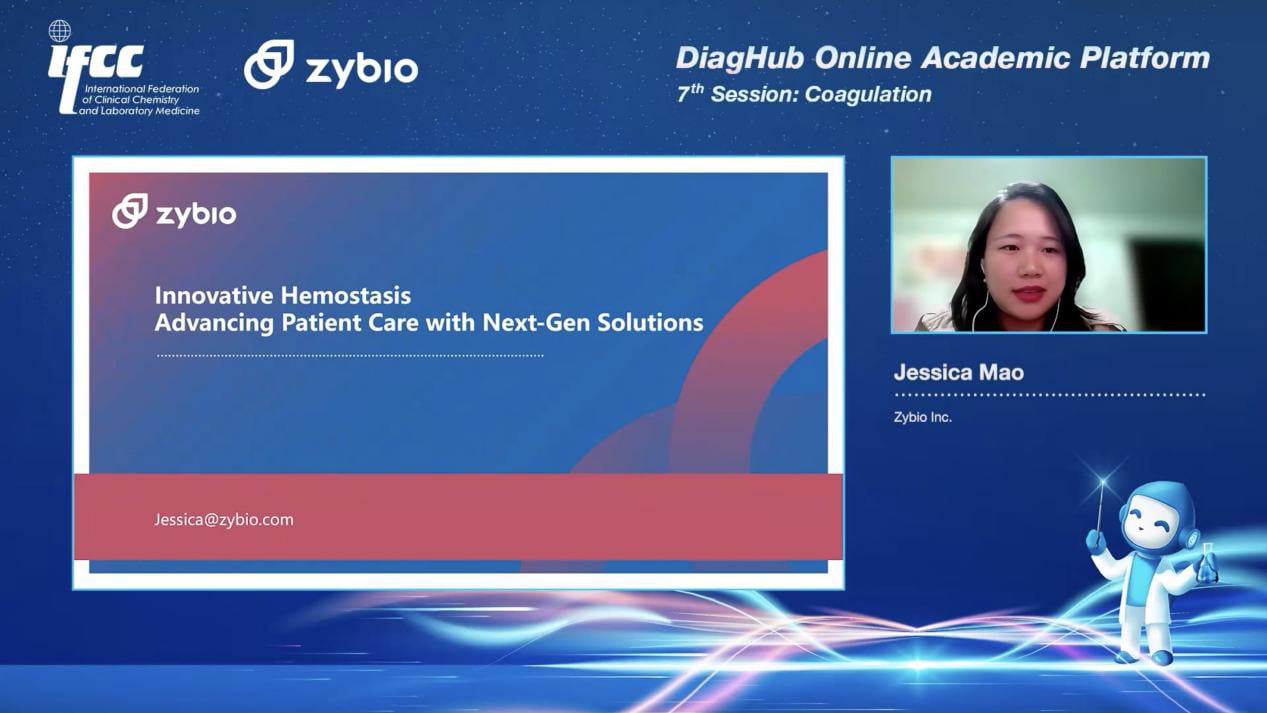DiagHub Online Academic Platform
The seventh session on Coagulation Concludes Successfully – Highlights Recap
Oct 31, 2025 Zybio News
The seventh session of DiagHub focused on coagulation diagnostics, convening global experts to discuss both laboratory challenges and technological breakthroughs in hemostasis testing. Moderated by Dr. Youmna Mourad, Laboratory Director at Al Hadi Laboratory in Lebanon, the session featured two keynote presentations: Dr. Cristhian Diaz Carhuamaca, Head of the Department of Clinical Pathology, and Blood Bank at Carlos LanFranco La Hoz Hospital, Peru, who addressed interference management in coagulation testing, and Ms. Jessica Mao, Product Manager at Zybio Inc., who presented on "Hemostasis: Advancing Patient Care with Next-Gen Solutions.

In his presentation, Dr. Cristhian Diaz Carhuamaca addressed the critical issue of interference in coagulation testing. His talk was structured around four main areas: preanalytical interference, technological principles, analytical interference, and Peruvian regulations.
Dr. Cristhian began by emphasizing the importance of the preanalytical phase, highlighting that factors such as patient history, diet, prolonged exercise, and specific blood sampling, processing, transportation, and centrifugation procedures can significantly impact coagulation test results. He provided key recommendations to standardize these steps and minimize preanalytical errors.
He then explained the fundamental technological principles behind coagulation analyzers, primarily comparing optical and mechanical clot detection methods. A significant portion was dedicated to analytical interference, focusing on the pervasive challenges posed by Hemolysis, Icterus, and Lipemia (HIL). He detailed how each interferent can cause biologically significant inaccuracies in common tests like PT, APTT, and D-dimer. To combat this, he presented an integrated solution: a platform that automatically detects HIL samples using the optical method and reflexively re-tests them using the robust mechanical method, ensuring result reliability.
Finally, Dr. Cristhian contextualized the discussion within the Peruvian healthcare framework, outlining national regulations that mandate quality standards and specify required equipment for different categories of health facilities, underscoring the local relevance of implementing robust testing protocols.

Ms. Jessica Mao from Zybio detailed the company's innovative advancements in hemostasis testing, addressing key challenges in routine coagulation analysis. She introduced the MOCAP (Mechanical and Optical Coagulation Analysis Platform) technology, which integrates optical and mechanical methods to eliminate compromises between cost-effectiveness and reliability, especially for samples with interferences like lipemia, icterus, and hemolysis.
The core innovation is the EXT 9800 platform, which synergizes three methods: optical, mechanical, and the groundbreaking Micro-Magnetic Particle method. This technology allows for visualized, cellular-level observation of clot formation, providing multi-parametric data beyond traditional clotting times. It enables morphological assessment of clot quality and the derivation of novel parameters, offering new clinical insights for identifying subtle disorders like dysfibrinogenemia, as demonstrated in case studies.
Furthermore, Ms. Jessica presented compelling clinical evidence showing excellent correlation between Zybio's EXT 9800 and a leading reference system. She also highlighted the superior performance of Zybio's dedicated reagents, notably the high heparin resistance of the PT reagent for precise warfarin monitoring and the enhanced sensitivity of the APTT reagent in detecting coagulation dysfunction in critical scenarios like sepsis. Overall, the presentation positioned Zybio's solutions as a significant leap forward, transforming coagulation testing from a simple endpoint measurement into a dynamic, multi-dimensional, and intelligent diagnostic process.

The session concluded with an engaging Q&A segment where the speakers addressed questions from the audience. Dr. Cristhian Diaz Carhuamaca elaborated on the advantages and limitations of mechanical clot detection methods for HIL samples, while Ms. Jessica Mao provided detailed insights into the novel clinical parameters enabled by the magnetic microparticle cluster method.
These discussions provided actionable strategies for optimizing coagulation workflows, highlighting the critical role of technological integration in elevating hemostasis diagnostics. We invite you to stay engaged with future DiagHub sessions as we continue to bridge global expertise and drive innovation in laboratory medicine!
